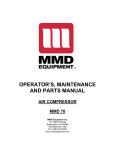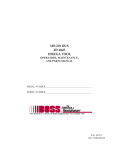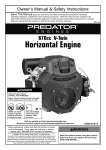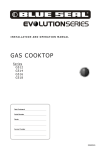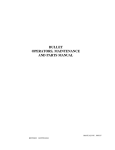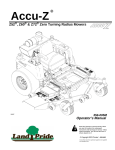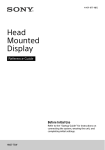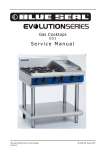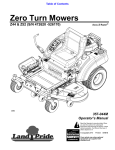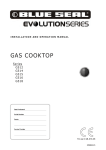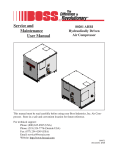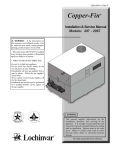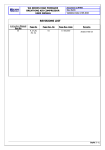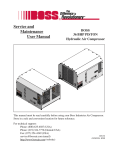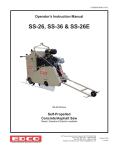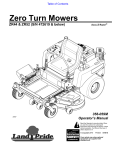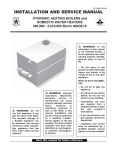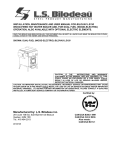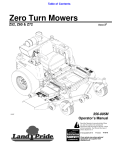Download 307239 24HP RX-70 - Boss Industries, Inc.
Transcript
BOSS RX70 24HP OPERATORS, MAINTENANCE AND PARTS MANUAL P/N: 307239 11/29/2010 MCM TABLE OF CONTENTS Operation & Maintenance Section Page Specifications ............................................................................................................... 6 Safety ............................................................................................................................ 7 Description of Components ...................................................................................... 17 Compressor Operation ............................................................................................. 21 Compressor Inspection, Lubrication, and Maintenance ...................................... 25 Troubleshooting ......................................................................................................... 36 Recommended Spare Parts ...................................................................................... 39 Warranty Information/Claims ................................................................................. 40 Parts & Illustration Section ..................................................................................... 46 4 P/N:307239 SPECIFICATIONS COMPRESSOR SPECIFICATIONS ENGINE SPECIFICATIONS HONDA 4-CYCLE, VTWIN OHV AIR COOLED GASOLINE MODEL RX 70 TYPE DELIVERY (CFM) 70 CFM @ 100 PSIG (1.98M3/MIN) MODEL OPERATING 80-115 PSIG PRESSURE RANGE AMBIENT OPERATING -20° TO +105° TEMPERATURE FAHRENHEIT RANGE .75 GALLONS (2.83 OIL SUMP CAPACITY LITERS) TOTAL SYSTEM 1.0 GALLONS (3.80 CAPACITY LITERS) AIR SERVICE 1/2" NPT CONNECTIONS TYPE COOLING OIL TO AIR SYSTEM AIR INTAKE FILTER SINGLE STAGE DRY TYPE OF CONTROL 0 - 100% DEMAND 8 7 6 GX670 POWER @ 3600 RPM 24 HP (15.8kw) HP (kw) DISPLACEMENT cubic inches (cc) 40.9 cubic inches (670cc) B - 3.0 (77MM) & S 2.80 inches (72mm) OIL CAPACITY WITH 1.69 QUARTS (1.6 FILTER LITERS) 12V - 227cca @ O° BATTERY FAHRENHEIT 5.2 GALLONS (20 FUEL TANK CAPACITY LITERS) BORE & STROKE WEIGHT 430lbs (195kg) 5 4 3 2 1 Parts List D ITEM QTY 1 2 3 4 5 6 NS NS 1 1 1 1 1 1 1 1 PART NUMBER 200381 200367 200365 200366 200380 200215 307239 303807 DESCRIPTION INST. PANEL & PARTS, 24HP RX70 FRAME & PARTS, 24HP RX70 COMPRESSOR & PARTS, 24HP RX70 ENGINE & PARTS, 24HP RX70 COOLER & PARTS, 24HP RX70 HOSE AND PARTS, RX70 MANUAL, BOSS 24HP RX70 CRATE, SHIPPING BULLET 36X50X45 D 19 3/8 in [490.5 mm] C C 31 1/2 in [799.1 mm] B B 35 1/4 in [894.7 mm] 29 1/4 in [743.8 mm] 5 in [126.5 mm] 20 A 19 18 5/8 in [471.7 mm] 18 17 16 15 14 13 REV 58 3/4 in [1491.3 mm] 8 7 6 5 4 6 P/N:307239 UPDATED UPDATED REV 5 UPDATED UPDATED UPDATED UPDATED UPDATED UPDATED 200365 TO REV 12 200365 TO REV 11 & 200367 TO 200365 TO REV 10 200365 TO REV 9 200365 TO REV 8 200366 TO REV 2 200366 TO REV 1 200381 TO REV 3 DESCRIPTION REVISION HISTORY 3 11/8/2010 MCM 10/18/2010 MCM 9/20/2010 7/12/2010 6/16/2010 4/20/2010 3/22/2010 3/10/2010 DATE MCM CRH MCM CRH MCM DCL ENG PROPRIETARY INFORMATION MACHINED SURFACES UNMACHINED SURFACES R THIS DRAWING AND ALL ITS NOMINAL DIM. FRACTIONAL ` 1/16 CONTENTS ARE PROPERTY 0.000 TO 1.000 ` .010 DECIMAL ` .03 OF BOSS INDUSTRIES, INC. 1.001 TO 5.000 ` .015 ANGULAR ` 1° AND MUST NOT BE COPIED 5.001 TO 10.000 `.020 OR MADE PUBLIC. IT IS DO NOT SCALE DESCRIPTION TOLERANCES LOANED AND IS SUBJECT TO 10.001 & OVER `.025 UNLESS NOTED RETURN UPON DEMAND. THE INFORMATION CONTAINED IN DRAWN RX70 PORTABLE 24HP 2/12/2008 THIS DRAWING IS MCM CONFIDENTIAL AND MUST CHECKED 2/12/2008 NOT BE USED, DIRECTLY OR NDD SIZE SCALE DWG NO INDIRECTLY, IN ANY WAY MATERIAL D 1=4 20071-001 DETRIMENTAL TO THE N/A INTEREST OF BOSS PATH INDUSTRIES, INC. G:\Inventor Files\20k\20071-001.dwg 2 BOSS INDUSTRIES 1761 GENESIS DR. LA PORTE, IN 46350 REV 20 SHEET 1 1 OF 1 A SAFETY WARNING ALL UNITS ARE SHIPPED WITH A DETAILED OPERATORS, INSTALLATIONS AND PARTS MANUAL. THIS MANUAL CONTAINS VITAL INFORMATION FOR SAFE AND EFFICIENT OPERATION OF THIS UNIT. CAREFULLY READ THE OPERATORS MANUAL BEFORE STARTING THE UNIT. FAILURE TO READ AND COMPREHEND THE INSTRUCTIONS COULD RESULT IN SERIOUS BODILY INJURY OR PROPERTY DAMAGE. GENERAL The compressor is designed and manufactured to operate with relative safety. However, the responsibility for safe operation rests with those who use and maintain these products. The following safety precautions are offered as a guide, which, if conscientiously followed, will minimize the possibility of accidents throughout the useful life of this equipment. Only those who have read and understand this operator’s manual should operate this air compressor. Failure to follow the instructions, procedures and safety precautions in this manual may increase the possibility of accidents and injuries. Never start this air compressor unless it is safe to do so. Do not attempt to operate the air compressor with a known unsafe condition. Tag the air compressor and render it inoperative by disconnecting the battery so others who may not know of the unsafe condition will not attempt to operate it until the unsafe condition is corrected. Use and operate this air compressor only in full compliance with all pertinent OSHA requirements and all pertinent Federal, State and Local codes or requirements. Do not modify this compressor except with written factory approval. Any unauthorized modification automatically voids the factory warranty. The operation of engine-powered equipment will always be somewhat dangerous. Do not consider this section to be complete, but always continue to be alert for hazards. PARKING OR LOCATING COMPRESSOR Locate compressor on level areas, if possible. If not, locate compressor across grade, so the compressor does not tend to roll down hill. Do not locate compressor on grades exceeding 15 degrees (27%). Make sure compressor is parked or located on a firm surface that can support its weight. Locate compressor so the wind, if any, tends to carry the engine exhaust fumes and radiator heat away from the compressor air inlet openings and also where the compressor will not be exposed to excessive dust from the work site. Muffler side of package must have 12 inches of clearance so engine-cooling air can escape from package without restriction or re-circulation. The topside of package at the compressor oil cooling fan must also have 12 inches of clearance so cooling air can escape from package without restriction or re-circulation. Block or chock both sides of all wheels. 7 P/N:307239 SAFETY PRESSURE RELEASE Install the appropriate flow limiting valves between the compressor service air outlet and the shut-off (throttle) valve. Air hoses exceeding 1/4” inside diameter are to be connected to the shut-off (throttle) valve to reduce pressure in case of hose or connection failure, per OSHA Standard 29 CFR 1926.302 (as) (7). When the hose is to be used to supply a manifold, install an additional appropriate flow limiting valve between the manifold and each air hose exceeding 1/4” inside the diameter that is to be connected to the manifold to reduce pressure in case of hose failure. Provide a flow-limiting valve every 75 feet of hose in runs of air hose exceeding 1/4” inside diameter to reduce pressure in case of hose failure. Flow limiting valves are listed by pipe size and rated CFM. Select appropriate valves accordingly. Do not use tools that are rated below the maximum relief valve rating on this compressor. Select tools, air hoses, pipes, valves, filters and fittings accordingly. Do not exceed manufacturer’s rated safe operating pressures for these items. Secure all hose connections by wire, chain or other suitable retaining devices to prevent tools or hose ends from being accidentally disconnected and expelled. Open compressor oil filler cap only when compressor is not running and is not pressurized. Shut down the compressor and bleed the sump (open service valve) pressure to zero before removing the oil filler cap. Vent all internal pressure prior to opening any line, fitting, hose, valve, drain plug, connection or other components such as filters or line oilier, and before attempting to refill optional air line anti-ice systems with antifreeze compound. Keep personnel out of line with and away from the discharge opening of hoses or tools or other points of compressed air discharge. Do not use air pressures higher than 30 PSIG (207kPa) for cleaning purposes, and then only with effective chip guarding and personal protective equipment per OSHA Standard 29 CFR 1910.242 (b). Do not play with air hoses, as serious injury or death may result. 8 P/N:307239 SAFETY FIRE AND EXPLOSION Refuel at a service station or from a fuel tank designed for its intended purpose. If this is not possible then, ground the machine to the dispenser prior to refueling. Immediately clean up any spills or leaking fuel, battery electrolyte, oil or antifreeze solution. Shut off the air compressor and allow it to cool. Then keep sparks, flames and other sources of ignition away and do not permit smoking in the vicinity when adding fuel, when checking or adding electrolyte to batteries, when checking or adding oil, or when refilling air line anti-ice systems with antifreeze compound. Do not permit liquids, including air line anti-ice system antifreeze compound or oil film to accumulate on bottom covers or on, under or around any external or internal surfaces of the air compressor. Wipe down using an industrial cleaner or steam clean as required. Do not use flammable solvents for cleaning purposes. Disconnect the ground (negative) battery connection prior to attempting any repairs or cleaning inside the enclosure. Tag the battery connection so others will not unexpectedly reconnect it. Keep electrical wiring, including the battery terminals and other terminals, in good condition. Replace any wiring that has cracked, cut, abraded, or otherwise degraded insulation; or terminals that are worn, discolored or corroded. Keep all terminals clean and tight. Turn off battery charger before making or breaking connections to the battery. Keep grounded conductive objects such as tools away from exposed live electrical parts such as terminals, to avoid arcing, which might serve as a source of ignition. Replace damaged fuel tanks or lines immediately, rather than attempting to repair them. Do not store or attempt to operate the compressor with any known leaks in the fuel system or any oil lines. Remove any other material that may be damaged by heat or that may support combustion, including anti-ice system components containing antifreeze compound, prior to attempting weld repairs. Keep a suitable fully charged class BC or ABC fire extinguisher or extinguishers nearby when servicing and operating the compressor. Do not store any type of containers with fuel or lubricants inside, or outside of canopy. Keep oily rags, trash, leaves, litter or other combustibles out of and away from the compressor. Open all access doors and allow the enclosure to ventilate prior to attempting to start the engine. (Use this time to check the engine and compressor oil levels, etc.) Do not operate compressor under low overhanging leaves or permit such leaves to contact hot exhaust system surfaces when operating in forested areas. Do not attempt to use ether as a starting aid in gasoline engines, as serious personal injury or property damage may result. 9 P/N:307239 SAFETY FIRE AND EXPLOSION (CONT.) Antifreeze compound used in air line anti-ice systems contains methanol, which if flammable. Use systems and refill with compound only in well-ventilated areas away from heat, open flames, or sparks. Do not expose any part of these systems or the antifreeze compound to the temperatures above 150 degrees F (65 degrees C). Vapors from the antifreeze compound are heavier than air. Do not store compound or discharge treaded air in confined or unventilated area. Do not store containers or antifreeze compound in direct sunlight. MOVING PARTS Keep hands, arms and other parts of the body and also clothing away from belts pulleys and other moving parts. Do not attempt to operate the compressor with the fan guard or other guards removed. Wear snug fitting clothing and confine long hair when working around this compressor, especially when exposed to hot or moving parts inside the enclosure. Keep access doors closed except when making repairs, adjustments or performing service. Make sure all personnel are clear of the compressor prior to attempting to start to operate it, or shutting it off. Shut off engine before adding fuel, oil, lubrications, air line anti-freeze compound, or battery electrolyte. Disconnect the grounded negative battery connection to prevent accidental engine operation prior to attempting repair or make adjustments. Tag the battery connection so others won’t unexpectedly reconnect it. (Use appropriate lockout / tag-out procedures). Make adjustments only when the engine is shut off. When necessary, make adjustment, and then start engine to check adjustment. If adjustment is incorrect shut off engine, readjust, and then restart engine to recheck adjustment. 10 P/N:307239 SAFETY HOT SURFACES, SHARP EDGES AND SHARP CORNERS, VACUUM Avoid bodily contact with hot oil, hot coolant, hot surfaces and sharp edges and corners. Keep all parts of the body away from all points of air discharge and away from hot exhaust gases. Wear personal protective equipment, including gloves and head covering when working in, on, or around the compressor. Keep a first aid kit handy. Seek medical assistance promptly in case of injury. Do not ignore small cuts and burns, as they may lead to infection. Keep all loose clothing and parts of the body away from engine, compressor, and air filter intakes. TOXIC AND IRRITATING SUBSTANCES Do not use air from this compressor for breathing except in full compliance with OSHA Standards 29 CFM 1920 and any other Federal, State or Local Codes or Regulations. Do not use air line anti-ice systems in air lines supplying respirators or other breathing air utilization equipment, and do not discharge air from these systems in non-ventilated or other confined areas. Operate the compressor only in open or well-ventilated areas. If the machine is operated indoors, discharge engine exhaust outdoors, being certain that there are no exhaust system leaks. Locate this compressor so that exhaust is not apt to be carried towards personnel, air intakes servicing personnel areas, or towards the air intake of this or any other portable or stationary compressor. TOXIC AND IRRITATING SUBSTANCES (CONT.) Fuels, oils, coolants, lubricants and battery electrolyte used in this compressor are typical of the industry. Care should be taken to avoid accidental ingestion and/or skin or eye contact. In the event of indigestion, seek medical treatment promptly. Do not induce vomiting if fuel is ingested. Wash with soap and water in the event of skin contact. Wear an acid resistant apron and a face shield or goggles when servicing the battery. If electrolyte is spilled on skin or clothing, immediately flush with large quantities of water. If air line anti-ice system antifreeze compound enters the eyes or if fumes irritate the eyes, they should be washed with large quantities of clean water for 15 minutes. A physician, preferably an ophthalmologist, or eye specialist, should be contacted immediately. The antifreeze compound used in air line anti-ice systems contains methanol and is toxic, harmful or fatal if swallowed. Avoid contact with the skin or eyes and avoid breathing the fumes. Call a physician immediately. expose live parts of the electrical system. 11 P/N:307239 SAFETY ELECTRICAL SHOCK Keep the compressor or equipment carrier, compressor hoses, tools and all personnel at least 10 feet from power lines and buried cables. Keep all parts of the body and any hand-held tools or other conductive objects away from exposed live parts of the electrical system. Maintain dry footing, stand on insulating surfaces and do not contact any other portion of the compressor when making adjustments or repairs to expose live parts of the electrical system. Attempt repairs only in clean, dry, well lighted and ventilated areas. LIFTING This compressor is provided with a lifting bail for routine lifting, loading onto trucks, etc. Compressors to be air lifted by helicopter must not be supported by the lifting bail, but by slings with appropriate spreader bars instead. In any event, lift only in full compliance with OSHA standards 29 CFR 1910 subpart N. Inspect lifting bail and points of attachment for cracked welds, for cracked, bent, corroded or otherwise degraded members, and for loose bolts or nuts prior to lifting. Make sure entire lifting, rigging and supporting structure has been inspected and is in good condition. Verify the rated capacity is at least the net weight of the compressor plus an additional 10% allowance for the weight of snow, ice, mud or stored tools and equipment. If you are unsure of the weight, then weigh the compressor before lifting. Make sure lifting hook has a functional safety latch, or equivalent, and is fully engaged once it has been lifted clear of the ground. Do not attempt to lift in high winds. Keep all personnel out from under and away from the compressor when suspended. Lift compressor slowly and smoothly, without jerking. Lift compressor no higher than necessary. Keep lift operators in constant attendance whenever compressor is suspended. Set compressor down only on level surfaces capable of supporting at least its net weight plus an additional 10% allowance for the weight of snow, ice, mud or stored tools and equipment. Chock both sides of wheels plus stabilizer legs before disengaging the lifting hook. 12 P/N:307239 SAFETY JUMP STARTING Observe all safety precautions mentioned elsewhere in this manual. Batteries may contain and/or generate gases that are flammable and explosive. Keep flames, sparks and other sources of ignition away. Batteries contain acid that is corrosive. Do not allow battery acid to contact eyes, fabrics, or painted surfaces, as serious personal injury or property damage may result. Flush any contacted areas thoroughly with water immediately. Wear an acid resistant apron and face shield when attempting to jump-start the compressor. Remove all vent caps from the battery in the compressor. Do not permit dirt or foreign matter to enter the open cells. Do not attempt to open sealed maintenance free batteries. Check fluid level. If low, bring fluid to proper level before attempting to jump-start. Do not attempt to jump-start if fluid is frozen or slushy. Bring batteries up to at least 40 degrees F (5 degrees C) before attempting to jump-start. Cover open cells of all compressor batteries with clean dampened cloths before attempting to jump-start. Attempt to jump start only with a vehicle with a negative ground electrical system with the same voltage and which is equipped with a battery of comparable size or larger than supplied with the compressor. Do not attempt to jump-start by using motor generator sets, welders, or other sources of DC power, as serious damage may result. Bring the starting vehicle alongside the compressor, but do not permit metal-to-metal contact between the compressor and the starting vehicle. Set the parking brakes of the starting vehicle, chock compressor wheels and stabilizer legs on both sides. * The use of maintenance-free batteries may eliminate this step. Place the starting vehicle in neutral or park, turn off all nonessential accessory electrical loads and start its engine. Use only jumper cables that are clean, in good condition, and are heavy enough to handle the starting current. Avoid accidental contact between jumper cable terminal clips or clamps and each other or any metallic portion of either the compressor or the starting vehicle to minimize the possibility of uncontrolled arcing, which might serve as a source of ignition. Positive battery terminals are usually identified by a plus (+) sign on the terminal and the letters POS adjacent to the terminal. Negative battery terminals are usually identified by a minus (-) sign on the terminal and the letters NEG adjacent to the terminal. Connect one end of a jumper cable to the positive POS (+) battery terminal in the starting vehicle. Connect one end of the other jumper cable to the grounded negative (NEG) terminal of the battery in the starting vehicle. 13 P/N:307239 SAFETY JUMP STARTING (CONT.) Connect one end of a jumper cable to the positive POS (+) battery terminal in the starting vehicle. Connect one end of the other jumper cable to the grounded negative (NEG) terminal of the battery in the starting vehicle. Check you connections. Do not apply 24V to a 12V system in the compressor. Connect the other end of this same jumper cable to a clean portion of the compressor engine block away from fuel lines, the crank case breather opening, and the battery. Start the compressor in accordance with normal procedure. Avoid prolonged cranking. Allow the compressor to warm-up. When the compressor is warm and operating smoothly at normal ideal RPM, disconnect the jumper cable from the engine block on the compressor, then disconnect the other end of this same cable from the grounded negative (NEG) terminal of the battery in the starting vehicle. Then disconnect the other jumper cable from the positive (POS) (+) terminal of the battery in the compressor, and finally, disconnect the other end of this same jumper cable from the positive (POS) (+) terminal of the battery in the starting vehicle. 14 P/N:307239 SAFETY NOTE THE OWNER, LEASER, OR OPERATOR OF THE COMPRESSOR IS HEREBY NOTIFIED AND FOREWARNED THAT ANY FAILURE TO OBSERVE THESE SAFETY PRECAUTIONS MAY RESULT IN DAMAGE OR INJURY NOTE BOSS INDUSTRIES EXPRESSLY DISCLAIMS RESPONSIBILITY OR LIABILITY FOR ANY INJURY OR DAMAGE CAUSED BY FAILURE TO OBSERVE THESE SPECIFIED PRECAUTIONS OR BY FAILURE TO EXERCISE THAT ORDINARY CAUTION AND DUE CARE REQUIRED WHEN OPERATING OR HANDLING THE COMPRESSOR, EVEN THOUGH NOT EXPRESSLY SPECIFIED ABOVE. Compliments of warning decals are supplied with each unit. These decals are affixed to the unit after it has been painted, prior to being put into service. The decals are placed so as to be clearly visible to the user and service personnel. P/N: 300039 P/N: 300038 15 P/N:307239 SAFETY P/N 300042 P/N 300040 P/N 300041 P/N 300968 16 P/N:307239 DESCRIPTION OF COMPONENTS POWER UNIT The power unit used to drive the compressor is a gasoline engine that has been carefully selected for its ability to provide an efficient and reliable source of power. For detailed information on the power unit, refer to the Engine Operator’s Manual provided separately. COMPRESSOR ASSEMBLY The RX70 compressor assembly is a positive displacement, oil flooded, rotary screw type unit employing one stage of compression to achieve the desired pressure. Components include a housing (stator) two screws (rotors), bearings and bearing supports. The power source drives the male rotor through the inlet housing. The male rotor drives the female rotor. PRINCIPLES OF OPERATION In operation, two helical grooved rotors mesh to compress air. Inlet air is trapped as the male lobes roll down the female grooves, pushing trapped air along, compressing it until it reaches the discharge port in the end of the stator and delivers smooth-flowing, pulse-free air to the receiver. During the compression cycle, oil is injected into the compressor and serves these purposes: 1. Lubricates the rotating parts and bearings. 2. Serves as a cooling agent for the compressed air. 3. Seals the running clearances. LUBRICATION SYSTEM Oil from the compressor oil sump, at the compressor discharge pressure, is directed through the oil cooling system, then the oil filter, and back to the compressor stator, where it is injected into the compressor. At the same time oil is directed to the bearings and shaft seal of the compressor. SAFETY VALVE The pop safety valve is set at 175 PSI and is located at the top of the air/oil sump. This valve acts as a backup to protect the system from excessive pressure that might result from a malfunction. AIR/OIL COALESCER The coalescer is self-contained within a spin-on housing and is separate of the sump. When air is demanded at the service line, it passes through the coalescer, which efficiently provides the final stage of oil separation. MINIMUM PRESSURE VALVE The minimum pressure valve is located at the outlet of the compressor and serves to maintain a minimum discharge pressure of 60 PSIG in operation, which is required to assure adequate compressor lubrication pressure, and air/oil separation at the coalescer element. OIL FILTER The compressor oil filter is the full-flow replaceable element type and has a safety by-pass built into it. This element screws directly to the compressor stator housing. See Compressor Mounting System in the illustration section. 17 P/N:307239 DESCRIPTION OF COMPONENTS COMPRESSOR COOLING SYSTEM The compressor cooling system consists of an oil cooler and electric fan assembly. See Cooler and Parts System in the illustration section. An automated thermostatic control system maintains a continuous temperature check of the lubricant. The fan sensor trips a normally open relay which sends power to the fan motor once compressor oil temperature reaches 190°F. The fan sensor stops power to the fan motor once the compressor oil temperature drops to 160°F. INSTRUMENT PANEL AND OPERATING CONTROLS The instrument panel contains all the necessary gauges and instruments for operation and is located outside of the main enclosure. The following is an explanation of their use. See Electrical System & Wiring Diagram in the illustration section. 1. Start (key) The starter switch is used to electrically energize the engine starter motor solenoid to begin cranking of engine. 2. Choke (Gasoline Engine Only) The choke is used to provide a richer fuel mixture to the engine for cold starts. Pulling the choke cable out increases the fuel mixture. As the engine warms up, the choke should be pushed inward. The engine should operate without choking as soon as possible after starting to avoid flooding or dilution of lubricating oil. 3. Hourmeter The hourmeter records the total number of operating hours. It serves as a guide towards following the recommended inspection and maintenance schedule. 4. Pressure Meter The pressure meter displays compressor discharge air pressure. This meter also has a shutdown feature and will shutdown the engine if the discharge air pressure reaches 150 psi. 5. Temperature Meter The temperature meter displays compressor discharge air temperature. This meter also has a shutdown feature and will shutdown the engine if the discharge air reaches 250°F. Note: If the compressor shuts down on high discharge air pressure or high discharge air temperature, find and fix the problem before restarting. Also, the shutdown relay reset button must be reset before the engine can be restarted. CONTROL SYSTEM The prime components of the compressor control system include the compressor inlet valve and an air cylinder. The control system is designed to match air supply to air demand and to prevent excessive discharge pressure when compressed air is not being used. Control of air delivery is accomplished by the inlet valve regulation as directed by the discharge pressure regulator. 18 P/N:307239 DESCRIPTION OF COMPONENTS CONTROL SYSTEM OPERATION The following discussion explains the operation of the control system from a condition of “no load” to a condition of ‘full capacity” at working pressure. For the working pressure range of your machine, refer to applicable data in the specification sections. The pressure Regulator and engine speed regulating cylinder operates as follows: 1. As the demand for air decreases, the receiver pressure rises; and when this pressure exceeds the set point of the pressure regulator, the regulator opens sending a pressure signal to the inlet valve, and to the regulating cylinder. a. The inlet valve disc moves towards the valve inlet against the force of the modulating spring inside the valve. This regulates the opening area of the inlet valve. b. The regulating cylinder will reduce engine speed somewhere between full load and compressor idle. 2. If the air demand goes to zero, (service valve closed) the inlet valve will close completely, and the regulating cylinder will bring the engine to compressor idle. 3. As the demand for air increases, receiver pressure drops slightly below the set point of the pressure regulator eliminating the signal to the inlet valve and regulator cylinder. a. Inlet valve disc opens fully. b. Regulating cylinder retracts allowing the engine governor spring to bring the engine and compressor up to its high rpm. INLET VALVE The compressor inlet valve is a piston operated disc valve that has a dual function of regulating the inlet opening to control capacity and serving as a check valve at shutdown. DISCHARGE PRESSURE REGULATOR VALVE This valve is used to select the desired discharge pressure within the operating pressure range. Turning the regulator screw clockwise increases the working pressure, a counter-clockwise movement of the screw reduces working pressure. Do not set pressure over 125 psi. Normal set pressure is 80 to 120 psig. COMPRESSOR DISCHARGE PRESSURE GAUGE This gauge indicates the discharge air pressure. Operate compressor with discharge pressure within 80 to 120 PSIG. AUTOMATIC BLOW DOWN VALVE The automatic blow down valve. This valve will automatically bleed the sump to zero pressure when the compressor is stopped. 19 P/N:307239 DESCRIPTION OF COMPONENTS ELECTRICAL AND PROTECTIVE CIRCUIT SYSTEM The compressor electrical system is a 12-volt negative ground type. It is equipped with a protective circuit to minimize damage which could be caused by high compressor discharge temperature, or high discharge pressure. See wiring diagram and electrical system in the illustrations section. The following conditions will cause automatic shutdown of the compressor: 1. Compressor discharge temperature switch exceeds approximately 250°F. 2. Compressor discharge pressure that exceeds 150 psi. NOTE WHENEVER THE OPERATION OF THE PROTECTIVE CIRCUIT SHUTS THE MACHINE OFF, THE RESET BUTTON ON THE CONTROL PANEL MUST BE RESET (PUSHED IN) BEFORE YOU CAN RESTART THE COMPRESSOR. “DO NOT” RESTART THE COMPRESSOR UNTIL THE CAUSE OF THE SHUTDOWN IS FOUND AND FIXED. DUE TO THE FACT THAT THE COMPRESSOR PROTECTIVE CIRCUIT IS AN “ENERGIZED TO RUN” SYSTEM, ANY INTERRUPTION OF CURRENT WILL SHUT THE UNIT DOWN. IN EVENT OF AUTOMATIC SHUTDOWN, IT IS ALWAYS GOOD POLICY TO CHECK FOR LOOSE OR BROKEN WIRES OR CORRODED CONNECTIONS BY THE SHUTDOWN SWITCH LOCATED IN THE DISCHARGE LINE AT SUMP. IF THE ELECTRICAL SYSTEM CHECKS OUT PROPERLY, REFER TO TROUBLESHOOTING SECTION. 20 P/N:307239 COMPRESSOR OPERATION GENERAL Every RX70 compressor has been operated and tested at the factory before shipment. This testing assures that the unit is operating properly and that the compressor will deliver its rated capacity. Regardless of the care taken at the factory, there still exists a possibility that damage may occur during shipment. For this reason, it is recommended that the unit be carefully inspected for evidence of damage in shipment. During the first few hours of operation the machine should be carefully observed for any possible malfunction. Satisfactory performance of the machine depends on the operator’s knowledge of the controls, instruments, and recommended operating procedures. Consequently, the preceding sections of this manual should be read and understood before attempting to start and operate this machine. PREPARATION FOR INITIAL START-UP Inspect the compressor, engine, and other assemblies for loose connections or damage occurring during shipment. Position the compressor package on a level surface so the proper amounts of fluids can be added. Check the engine crankcase oil level. If required, add oil as recommended in the Engine Operator’s manual. Fill fuel tank with grade of fuel recommended in the Engine Operator’s manual. Connect negative battery cable to (-) battery terminal. Check the compressor oil sump level. If oil level is low, add ATF Dexron III. See below for fill plug and sight glass locations. DO NOT OVER FILL. NOTE PROPER COMPRESSOR OIL LEVEL SHOULD FILL HALF OF THE UPPER SIGHTGLASS WHEN THE COMPRESSOR IS LEVEL AND THE COMPRESSOR IS NOT RUNNING . OIL FILL UPPER SIGHT GLASS LOWER SIGHT GLASS OIL FILTER THERMAL VALVE OIL DRAIN 21 P/N:307239 COMPRESSOR OPERATION NORMAL STARTING - GASOLINE ENGINE 1. Inspect the compressor, engine, and other assemblies for loose connections or damage that might have occurred since the last operation. 2. Check engine oil and fluid levels. 3. Check compressor oil sump level. 4. Ensure service valves are closed. 5. Verify cold start switch is in the “ON” position. 6. Pull the choke out as required, but avoid flooding the engine. Release the choke as soon after starting as possible. 7. Turn engine start switch and hold until engine starts, but do not hold any longer than 10 seconds at a time. 8. Let the machine run for 3-5 minutes to allow the engine to warm-up. 9. Toggle the cold start switch to the “OFF” position. The system is now ready for full-load operation. 10. Service valves can now be opened. NOTE IF ENGINE SHOULD STOP, DO NOT ATTEMPT TO RESTART WITH THE OIL SUMP UNDER PRESSURE, ALLOW BLOW DOWN OF SUMP TO END. REPEAT THE ABOVE PROCEDURE FROM STEP 3. NORMAL STOPPING 1. Close the service valves. 2. Toggle cold start switch to the “ON” position. 3. Let the compressor run for a few minutes to allow machine to cool down an for system pressure to unload. 4. Turn key to OPERATING UNDER EXTREME CONDITIONS When operating the compressor in extreme conditions, perform the following service functions as applicable. COLD WEATHER OPERATION When operating in lower than -20 degrees F ambient, change engine oil per engine owner’s manual and let the engine and compressor warm-up before opening the service valve. HOT WEATHER OPERATION Keep the engine filled with clean oil and check the oil level more frequently than usual. Keep the outside of the compressor oil cooler clean. Locate the unit in a well-ventilated area. When operating in humid conditions, it is recommended that the compressor oil change interval be shortened. DUSTY OR SANDY AREAS When possible, wet down the area surrounding the operating site to keep dust and blowing sand to a minimum. Inspect air filters more frequently. 22 P/N:307239 COMPRESSOR OPERATION WARNING CHECK THE COMPRESSOR SUMP OIL LEVEL ONLY WHEN THE COMPRESSOR IS NOT OPERATING AND SYSTEM IS COMPLETELY RELIEVED OF PRESSURE. OPEN SERVICE VALVE TO ENSURE RELIEF OF SYSTEM AIR PRESSURE WHEN PERFORMING MAINTENANCE ON COMPRESSOR AIR/OIL SYSTEM. FAILURE TO COMPLY WITH THIS WARNING MAY CAUSE PROPERTY DAMAGE AND SERIOUS BODILY HARM OR DEATH. OPERATING CONDITIONS For maximum compressor performance, the compressor should be as close to level as possible when operating. The compressor will operate on a 15-degree sideward lengthwise tilt without any adverse problems. Fluid carryover and oil starvation may occur if operated beyond this tilt. NOTE IF THE COMPRESSOR IS BEING USED TO POWER SANDBLASTING EQUIPMENT OR AN AIR TANK, USE A CHECK VALVE DIRECTLY AFTER THE SERVICE VALVE TO PREVENT BACK-FLOW INTO THE SUMP. THIS CHECK VALVE SHOULD HAVE A MAXIMUM PRESSURE DROP RATING OF 2 PSIG (13.78 kPa) OPERATING AND A CAPACITY RATING EQUAL TO THE MAXIMUM RATING OF THE COMPRESSOR. OPERATING SUGGESTIONS Replace any faulty gauge immediately. Allow at least ten feet of unobstructed area in front of the engine muffler to assure good airflow. Do not place items under the package. Check instruments periodically during operation. If not in normal operating zone, refer to Section 6, “Troubleshooting”. Make sure that correct type and viscosity lubricating oils and fuel are used, especially in extreme ambient temperatures. Keep batteries fully charged and properly maintained. Keep control linkage clean and lightly lubricated. 23 P/N:307239 COMPRESSOR OPERATION While BOSS Industries has built into its compressor several controls and indicators to assure you that it is running properly, you will want to recognize and interpret the readings which will call for service or indicate the beginning of a malfunction. Before starting the compressor, read this section thoroughly. Familiarize yourself with the controls and indicators, their purpose, location, and use. CONTROL OR INDICATOR PURPOSE AIR PRESSURE GAUGE Continually monitors the sump pressure at various load and unload conditions FAN SWITCH Monitors the temperature of the air/fluid mixture leaving the compressor unit. The normal reading should be approximately 140 to 220° Fahrenheit. Switch closes to activate fan motor. COMPRESSOR HIGH DISCHARGE Opens the electrical circuit to shut the machine down when the discharge TEMPERATURE SHUTDOWN temperature reaches 250° Fahrenheit. SWITCH Indicates the fluid level in sump. Proper level should fill half of the top sight FLUID LEVEL SIGHTGLASS glass. Check this level when the machine is shutdown. Vents sump pressure to the atmosphere should pressure inside the sump PRESSURE RELIEF VALVE exceed 175 PSIG. COMPRESSOR INLET CONTROL Regulates the amount of air intake in accordance with the amount of VALVE compressed air being used. Isolates fluid in compressor unit on shutdown. Senses air pressure from sump to provide automatic regulation of the PRESSURE REGULATING VALVE compressor inlet control valve and load controller. Restricts airflow to balance sump and service air pressure. Assures a MINIMUM PRESSURE VALVE minimum of 60 PSIG to the service line. 24 P/N:307239 COMPRESSOR INSPECTION, LUBRICATION, AND MAINTENANCE This section contains instructions for performing the inspection, lubrication and maintenance procedures required in maintaining the compressor in proper operating condition. The importance of performing the maintenance described herein cannot be over emphasized. Periodic maintenance procedures to be performed on the equipment covered by this manual are listed below. It should be understood that the intervals between inspections specified are maximum intervals. More frequent inspections should be made if the unit is operating in a dusty environment, in high ambient temperature, or in other unusual conditions. A planned program of periodic inspection and maintenance will help to avoid premature failure and costly repairs. Daily visual inspections should become a routine. The LUBRICATION AND MAINTENANCE CHART lists serviceable items on this compressor package. The items are listed according to their frequency of maintenance, followed by those items which need only “As Required” maintenance. The maintenance time intervals are expressed in hours. Use the hourmeter readings for determining your maintenance schedules. Perform the maintenance at multiple intervals of the hours shown. For example, when the hourmeter shows “100” on the dial, all items listed under “EVERY 10 HOURS” should be serviced now for the tenth time, and all items under “EVERY 50 HOURS” should be served for the second time. In addition to the following LUBRICATION AND MAINTENANCE CHART refer to the Engine Operator’s manual for recommended engine lubrication and maintenance. DANGER COMPRESSOR MUST BE SHUT DOWN AND COMPLETELY RELIEVED OF PRESSURE PRIOR TO CHECKING FLUID LEVELS. OPEN SERVICE VALVE TO ASSURE RELIEF OF SYSTEM AIR PRESSURE. FAILURE TO COMPLY WITH THIS WARNING MAY CAUSE DAMAGE TO PROPERTY AND SERIOUS BODILY HARM. 25 P/N:307239 COMPRESSOR INSPECTION, LUBRICATION, AND MAINTENANCE CHART INTERVAL EVERY 10 HOURS OR DAILY EVERY 50 HOURS OR WEEKLY EVERY 500 HOURS OR 6 MONTHS EVERY 1000 HOURS OR 1 YEAR EVERY 2000 HOURS OR 1 YEAR PERIODICALLY OR AS REQUIRED ACTION 1. Check compressors oil level. 2. Check air filter. 3. Check for oil and air leaks. 4. Check fuel supply after running. 5. Check for fuel, oil and compressor fluid leaks. 1. Drain water from compressor oil at sump. 2. Check belt tension. 3. Drain water and sediment from fuel tank. 1. Change compressor oil and oil filter. 2. Check air filter piping, fittings and clamps. 3. Install new air filter element. (Shorter interval may be necessary under dusty conditions). 4. Check tire pressure. 5. Check for excessive wear on drive belts. Replace if necessary. 1. Check safety circuit switches. 2. Clean battery terminals. 3. Check compressor shaft seal for leakage. 1. Install new air filter element. (Shorter interval may be necessary under dusty conditions). 1. Inspect air filter element 2. Replace spin-on coalescer element if necessary. 3. Inspect and clean compressor oil system cooler, etc. 4. Check engine speed control adjustment, at hi-low compressor settings. 5. Inspect lifting frame (before each lift). 6. Grease wheel bearings 7. Check engine and compressor supports. NOTE: See Maintenance Section for clarification on above. 26 P/N:307239 COMPRESSOR INSPECTION, LUBRICATION, AND MAINTENANCE NOTE OBSERVE ALL GAUGE READINGS. NOTE ANY CHANGE FROM THE NORMAL READING AND DETERMINE THE CAUSE. HAVE NECESSARY REPAIRS MADE. “NORMAL” IS THE USUAL GAUGE READING WHEN OPERATING AT SIMILAR CONDITIONS ON A DAY-TO-DAY OPERATION. FIRST COMPRESSOR OIL AND OIL FILTER ELEMENT CHANGE SHOULD BE MADE AT 50 HOURS. ALSO, MORE FREQUENT OIL CHANGES WILL BE REQUIRED UNDER EXTREME OPERATING CONDITIONS OF EXTREMELY HIGH OR LOW TEMPERATURES, AND HIGH HUMIDITY. CHANGE OIL EVERY SIX MONTHS, EVEN IF THE NORMAL OIL CHANGE PERIOD, IN HOURS, HAS NOT YET ELAPSED. ALWAYS WARM UP THOROUGHLY PRIOR TO CHANGING EITHER THE ENGINE OIL OR THE COMPRESSOR OIL. DO NOT OPEN COMPRESSOR OIL DRAIN; OIL FILTER CAP, OR OIL FILTER UNTIL ALL PRESSURE HAS BEEN RELIEVED. CHECK BY MANUALLY OPENING THE ASME SUMP PRESSURE RELIEF VALVE. 27 P/N:307239 LUBRICATION LUBRICANT RECOMMENDATIONS WARNING IT IS IMPORTANT THAT THE COMPRESSOR FLUID BE OF A RECOMMENDED TYPE AND THAT THIS OIL AS WELL AS THE AIR FILTER, OIL FILTER AND SEPARATOR ELEMENTS BE INSPECTED AND REPLACED AS STATED IN THIS MANUAL. THE COMBINATION OF A SEPARATOR ELEMENT LOADED WITH DIRT AND OXIDIZED OIL PRODUCTS TOGETHER WITH INCREASED AIR VELOCITY AS A RESULT OF THIS CLOGGED CONDITION MAY PRODUCE A CRITICAL POINT WHILE THE MACHINE IS IN OPERATION WHERE IGNITION CAN TAKE PLACE AND COULD CAUSE A FIRE IN THE OIL SUMP. FAILURE TO COMPLY WITH THIS WARNING MAY CAUSE DAMAGE TO PROPERTY AND SERIOUS BODILY HARM. The following general characteristics categorize lubricants that have been found to be satisfactory for use in helical screw type air compressors. Due to the impossibility of establishing limits on all physical and chemical properties of lubricants which can affect their performance in the compressor over a broad range of environmental influences, the responsibility for recommending and consistently furnishing a suitable heavy-duty lubricant must rest with the individual supplier. The lubricant supplier’s recommendation must, therefore, be based upon not only the following general characteristics, but also upon his own knowledge of the suitability of the recommended lubricant in helical screw type air compressors operating in the particular environment involved. CAUTION MIXING DIFFERENT TYPES OF BRANDS OF LUBRICANTS IS NOT RECOMMENDED DUE TO THE POSSIBILITY OF A DILUTION OF THE ADDITIVES OR A REACTION BETWEEN ADDITIVES OF DIFFERENT TYPES. 28 P/N:307239 LUBRICATION APPLICATION GUIDE Not all lubricating oils are suitable for rotary screw compressor use. The most satisfactory oils are the nondetergent types that contain high levels of corrosion, oxidation, and foam inhibitors. Your RX70 compressor is factory filled with Dexron® III ATF. Other non-detergent motor oils, SAE 10W, class SE or CD, and SAE 30 that meet the requirements below can be used. However, BOSS recomends you to use Dexron® III ATF. The viscosity of the oil chosen depends largely on the ambient operating temperature range. The oil must provide sufficient lubrication for bearings and rotors at operating temperature, and it must have a pour point low enough to provide fluidity at low starting temperatures. In general, the viscosity range represented by these SAE grades is satisfactory for the temperature range shown: +40° F to 120° F SAE 30 -10° F to 75° F SAE 10 W (-20° F Pour Point) -40° F to 100° F Auto Trans. Fluid (-50° F Pour Point) PRIME LUBRICANT CHARACTERISTICS 1. Flash point 400° F minimum (ASTM D-92 — COC). 2. Pour point must be at least 20° F lower than the lowest expected ambient temperature. 3. Contain rust and oxidation inhibitors. 4. Contain foam suppressers. SYNTHETIC DIESTER AND SYNTHESIZED HYDROCARBON LUBRICANTS OIL All elastomeric components and all metal used in the compressor are fully compatible with synthetic diester and synthesized hydrocarbon lubricants. The viscosity grade chosen for synthetic diester base or SHC lubricants should be based upon the suggested viscosity ranges listed under prime lubricant characteristics and the lubricant supplier. 29 P/N:307239 LUBRICATION NOTE UNKNOWN INFLUENCES OF ENVIRONMENTAL FACTORS SUCH AS THE INTAKE OF REACTIVE GASES OR VAPORS IN THE AIR MAY LEAD TO CHEMICAL CHANGES IN ANY OIL. CAUSING PREMATURE FAILURE OF THE LUBRICANT AND THE USEFUL LIFE OF ALL “EXTENDED LIFE” LUBRICANTS MAY BE SHORTER THAN QUOTED BY THE LUBRICANT SUPPLIER. BECAUSE THE NORMAL “DRAIN AND REPLACE” PERIOD MAY BE EXCEEDED USING SYNTHETIC LUBRICANTS, DIFFERING FROM THOSE SPECIFIED IN THIS MANUAL, BOSS ENCOURAGES THE USER TO CLOSELY MONITOR THE LUBRICANT CONDITION AND TO PARTICIPATE IN AN OIL ANALYSIS PROGRAM WITH THE SUPPLIER. NOTE NO LUBRICANT, HOWEVER GOOD AND/OR EXPENSIVE, CAN REPLACE PROPER MAINTENANCE AND ATTENTION. SELECT AND USE IT WISELY. ENGINE LUBRICATION Refer to Engine Operator’s manual for recommended engine lubricating oil. 30 P/N:307239 MAINTENANCE COMPRESSOR OIL SUMP FILL, LEVEL, AND DRAIN Before adding or changing compressor oil make sure that the sump is completely relieved of pressure. Oil is added at the fill cap on the side of the compressor. A drain plug is provided at the bottom of the sump. The proper oil level, when unit is shutdown and has had time to settle is at the midpoint of the upper oil sightglass. The package must be level when checking the oil. DO NOT OVERFILL. The oil sump capacity is given in “Compressor Specifications”. OIL FILL UPPER SIGHT GLASS LOWER SIGHT GLASS OIL FILTER THERMAL VALVE OIL DRAIN DANGER WHILE COMPRESSOR IS RUNNING DO NOT ATTEMPT TO DRAIN CONDENSATE, REMOVE THE OIL LEVEL FILL PLUG OR BREAK ANY CONNECTION IN THE AIR OR OIL SYSTEM WITHOUT SHUTTING OFF COMPRESSOR AND MANUALLY RELIEVING PRESSURE FROM THE SUMP. FAILURE TO COMPLY WITH THIS WARNING MAY CAUSE DAMAGE TO PROPERTY AND SERIOUS BODILY HARM. AIR INTAKE FILTER The air intake filter is a heavy-duty single-stage high efficiency filter designed to protect the compressor from dust and foreign objects. See compressor mounting system in illustration section. Frequency of maintenance of the filter depends on dust conditions at the operating site. The filter element must be serviced when clogged (maximum pressure drop for proper operation is 15” H2O). 31 P/N:307239 MAINTENANCE AIR/OIL COALESCER The air/oil coalescer employs an element permanently housed within a spin-on canister. This is a single piece unit that requires replacement when it fails to remove the oil from the discharge air. To replace element, P/N 302600, proceed as follows: 1. 2. 3. 4. 5. 6. Shutdown compressor and wait for complete blow down (zero pressure). Turn element counterclockwise for removal (as viewed from bottom). Install new rubber seal in head and supply a film of fluid directly on the seal. Rotate element clockwise by hand until element contact seal (as viewed from bottom). Rotate element at top edge of can one more turn clockwise with band wrench. Run system and check for leaks. WARNING DO NOT SUBSTITUTE ELEMENT. USE ONLY A GENUINE BOSS INDUSTRIES REPLACEMENT ELEMENT. THIS ELEMENT IS RATED AT 200 PSI WORKING PRESSURE. USE OF ANY OTHER ELEMENT MAY BE HAZARDOUS AND COULD IMPAIR THE PERFORMANCE AND RELIABILITY OF THE COMPRESSOR, POSSIBLY VOIDING THE WARRANTY. COALESCER REGULATOR VALVE 1/2" FNPT SERVICE VALVE MINIMUM PRESSURE VALVE 32 P/N:307239 MAINTENANCE OIL FILTER The compressor oil filter is a cartridge, throw away type. It is designed with a built in by-pass so that if there is a large restriction, due to cold oil or clogged element, the compressor will still be lubricated. To replace filter proceed as follows: 1. 2. 3. 4. 5. 6. 7. Make sure system pressure is relieved. Unscrew with 14mm allen wrench. Remove oil filter from housing. Remove gasket and clean or replace the screen. Reinsert filter and gasket into housing and tighten with 14mm allen wrench. Add oil, re-tighten filler cap. Check for leaks in operation. WARNING DO NOT SUBSTITUTE ELEMENT. USE ONLY A GENUINE BOSS INDUSTRIES REPLACEMENT ELEMENT. THIS ELEMENT IS RATED AT 200 PSI WORKING PRESSURE. USE OF ANY OTHER ELEMENT MAY BE HAZARDOUS AND COULD IMPAIR THE PERFORMANCE AND RELIABILITY OF THE COMPRESSOR, POSSIBLY VOIDING THE WARRANTY. OIL FILL UPPER SIGHT GLASS LOWER SIGHT GLASS OIL FILTER THERMAL VALVE OIL DRAIN 33 P/N:307239 MAINTENANCE NOTE PARTS REQUIRED FOR ENGINE MAINTENANCE MAY BE FOUND IN THE ENGINE PARTS MANUAL, A COPY OF WHICH IS PROVIDED WITH EACH UNIT. FULL LOAD SPEED Using an air flow silencer, open service air valve until 100 PSI is being held on receiver pressure gauge. Be sure there is no air leakage from pressure regulator vent hole. With the use of an electronic photo tachometer, set the full load speed at 3500 - 3600 RPM. The governor spring tension held by an anchor bolt allows adjustments to be made. IDLE SPEED To adjust idle speed, close service air valve and set idle speed to 2000 - 2500 RPM by moving idle stop screw at carburetor as required. For operation at higher altitudes, it may be desirable to raise the idle speed to improve part load response and acceleration. High altitude engine kits are available. ENGINE INSPECTION, LUBRICATION AND MAINTENANCE The following is a regular schedule of inspection and servicing for the engine based on operating hours. Use the factory recommended Periodic Maintenance Schedule (based on favorable operating conditions) to serve as a guide to get long and efficient engine life. Regular service periods are recommended for normal service and operating conditions. For severe duty, extreme temperature, etc., service more frequently. Neglecting routine maintenance can result in engine failure or permanent damage. For any abnormalities in operation, unusual noises from the engine or accessories, loss of power, overheating, etc. contact your nearest Honda Service Center. BELT TENSIONING PROCEDURE 1. Use a 9/16" wrench and a 15/16" socket wrench to set the tension on the belt. Turn the 15/16" bolt, on the front of the tensioner, clockwise to set the tension. Use the 9/16" wrench to tighten the bolt on the backside of the tensioner bracket to hold the tensioner arm in place. 2. Proper tension is 1/4" deflection with a deflection force of 9.4 lbs minimum to 13.8 lbs maximum. BELT REPLACEMENT PROCEDURE 1. Remove compressor belt guard. 2. Use a 9/16" wrench and a 15/16" socket wrench to release the tension on the belt. Hold the 15/16" bolt, on the front of the tensioner, use the 9/16" wrench to loosen the bolt on the backside of the tensioner bracket. Turn the 15/16" bolt counter-clockwise until the tension is fully released from the belt. 3. Remove the old belt. 4. Install new belt. 5. Use a 9/16" wrench and a 15/16" socket wrench to set the tension on the belt. Turn the 15/16" bolt, on the front of the tensioner, clockwise to set the tension. Use the 9/16" wrench to tighten the bolt on the backside of the tensioner bracket to hold the tensioner arm in place. 6. Use a belt tensiometer to properly tension the belt. 7. Proper tension is 1/4" deflection with a deflection force of 9.4 lbs minimum to 13.8 lbs maximum. 34 P/N:307239 MAINTENANCE ENGINE, INSPECTION, LUBRICATION, AND MAINTENANCE CHART AFTER EACH CYCLE OF INDICATED HOURS SERVICE THESE ITEM S HOURS 8 INSPECT ENGINE GENERALLY X CHECK OIL LEVEL X 25 50 100 SERVICE AIR CLEANER ELEMENT WRAPPER X CHANGE CRANKCASE OIL (ALL ENGINES WITHOUT FILTER) X CHANGE CRANKCASE OIL (STANDARD WITH FILTER) X CHANGE CRANKCASE OIL (HIGH CAPACITY BASE WITH FILTER) X X REPLACE OIL FILTER X X 200 500 X CHECK BATTERY ELECTROLYTE LEVEL X CLEAN COOLING FANS X REPLACE AIR CLEANER ELEMENT X REPLACE FUEL FILTER X CHECK OR REPLACE SPARK PLUGS X 1. Check for fuel leaks. With engine running, visually and audibly check exhaust system for leaks. 2. Perform more often when running under severe operating conditions. 3. Required for initial break-in only. 4. For detailed maintenance, refer to the HONDA SERVICE MANUAL. 35 P/N:307239 TROUBLESHOOTING This section contains instructions for troubleshooting the equipment following a malfunction. The troubleshooting procedures to be performed on the equipment are listed below. Each symptom of trouble for a component or system is followed by a list of probable causes of the trouble and suggested procedures to be followed to eliminate the cause. In general, the procedures listed should be performed in the order in which they are listed, although the order may be varied if the need is indicated by conditions under which the trouble occurred. In any event, the procedures that can be performed in the least amount of time and with the least amount of removal or disassembly or parts should be performed first. MACHINE WILL NOT START 1. High pressure or high temperature safety trip. Reset safety relay. Push button in on control panel. 2. Check fuel level and add fuel if necessary. 3. Plugged fuel filter and replace if necessary. 4. Low battery voltage, recharge if necessary. 5. Loose battery cables, tighten cable; dirty battery cables, clean thoroughly. 6. Plugged air filter, replace the element. 7. Engine problems may have developed, refer to your Engine Manual. 8. Defective engine oil level switch, check continuity and replace if necessary. 9. Blown fuse in wiring harness, check continuity of fuse and replace if necessary. Fuse located by engine starter solenoid. UNPLANNED SHUTDOWN When the operation of the machine has been interrupted by an unexplained shutdown, check the following: 1. Check to determine if compressor oil is at proper level. 2. Check oil cooler for dirt, slush, ice on the fins, or any other obstructions to cooling airflow. 3. Make a thorough external check for any cause of shutdown such as broken hose, broken oil lines, loose or broken wire, etc. 4. Check electric fan motor and wiring. 5. Check fuses in wire harness, check continuity of fuse and replace if necessary. Fuse located by starter solenoid. 6. Check the engine oil level with the engine stopped and in a level position. If the oil level is low, remove the oil filler cap, and fill to the upper limit mark on the dipstick with the recommended oil. ENGINE OVERHEATING 1. Low oil level, refill. 2. Air blockage into engine from blower/PTO side. 3. Air blockage from exhaust side of engine. 4. Dirty oil in engine. 36 P/N:307239 TROUBLESHOOTING IMPROPER DISCHARGE PRESSURE 1. If discharge pressure is too low, check the following: a. Too much air demand. b. Service valves open blowing to atmosphere. c. Leaks in service line. d. Restricted compressor inlet air filter. e. Faulty control system operation (regulator, inlet valve etc.) f. Low engine speed. 2. If discharge pressure is too high or safety valve blows, check the following: a. Oil separator plugged up. b. Faulty safety valve. c. Faulty regulator or set to high. d. Inlet valve leaking, or partially open. Loss of pressure signal to inlet valve from regulator causing inlet valve to stay open. COMPRESSOR Abnormal compressor oil consumption or oil in service line, check for the following: 1. 2. 3. 4. 5. 6. Over filling of oil sump. Leaking oil lines or oil cooler. Plugged oil return line: check entire line and check valve/orifice fitting at compressor port. Defective separator element. Compressor shaft seal leakage. Discharge pressure below 55 PSI. SEPARATOR PLUGGING If the separator element has to be replaced frequently because it is plugging up, it is an indication that foreign material may be entering the compressor inlet or the compressor oil is breaking down. Compressor oil can break down prematurely for a number of reasons. 1. Extreme operating temperature 2. Negligence in draining condensate from oil sump 3. Using the improper type of oil 4. Dirty oil. The complete inlet system should be checked for leaks. 37 P/N:307239 TROUBLESHOOTING HIGH COMPRESSOR DISCHARGE TEMPERATURE 1. Check compressor oil level. Add oil if required (see section for oil specifications). 2. Check electric fan and switch. 3. Clean outside of oil cooler. 4. Clean oil system (cooler) internally. 5. Plugged compressor oil filter. Change element. 6. Plugged oil return line, clean orifice and check valve. INSUFFICIENT AIR DELIVERY 1. Plugged compressor air filter, clean or replace. 2. Plugged air/oil separator. Replace separator element and also change compressor oil and oil filter at this time. 3. Defective pressure regulator, adjust or repair. 4. Engine speed too low, readjust engine speed. 38 P/N:307239 RECOMMENDED SPARE PARTS ENGINE M AINTENANCE PARTS 304968 ENGINE OIL FILTER 304969 ENGINE FUEL FILTER 304967 ENGINE AIR CLEANER ELEMENT 304971 SPARK PLUGS COM PRESSOR M AINTENANCE PARTS 307275 DRIVE BELTS (2 QTY) 307152 COMPRESSOR AIR CLEANER ELEMENT 302601 COMPRESSOR OIL FILTER 302600 COMPRESSOR COALESCING ELEMENT 302865 FAN SENSOR 307471 REGULATOR REPAIR KIT 307117 SHAFT SEAL REPAIR KIT SCI8D 39 P/N:307239 WARRANTY INFORMATION/CLAIMS 40 P/N:307239 WARRANTY Boss Industries, Inc.. (BOSS) warrants that this Rotary Screw Compressor unit conforms to applicable drawings and specifications approved in writing by BOSS. The unit assembly will be free from defects in material and workmanship for a period of two (2) years from the date of initial operation or thirty (30) months from the date of shipment, whichever period first expires. All other components and parts of BOSS manufacture, will be free from defects in material and workmanship for a period of one (1) year from the date of initial operation or eighteen (18) months from the date of shipment, whichever period first expires. If within such period BOSS receives from the Buyer written notice of and alleged defect in or non-conformance of the unit, all other components and parts of BOSS manufacture and if in the judgment of BOSS these items do not conform or are found to be defective in material of workmanship, BOSS will at its option either, (a) furnish a Service Representative to correct defective workmanship, or (b) upon return of the item F.O.B. BOSS original shipping point, repair or replace the item or issue credit for the replacement item ordered by Buyer, (Defective material must be returned within thirty (30) days of return shipping instructions from BOSS. Failure to do so within specified time will result in forfeiture of claim), or (c) refund the full purchase price for the item without interest. Factory installed units will also include warranty on installation for a period of one (1) year. This warranty does not cover damage caused by accident, misuse or negligence. If the compressor unit is disassembled the warranty is void. BOSS’s sole responsibility and Buyer’s exclusive remedy hereunder is limited to such repair, replacement, or repayment of the purchase price. Parts not of BOSS manufacture are warranted only to the extent that they are warranted by the original manufacture. BOSS shall have no responsibility for any cost or expense incurred by Buyer from inability of BOSS to repair under said warranty when such inability is beyond the control of BOSS or caused solely by Buyer. There are no other warranties, express, statutory or implied, including those of merchantability and of fitness of purpose; nor any affirmation of fact or representation which extends beyond the description of the face hereof. This warranty shall be void and BOSS shall have no responsibility to repair, replace, or repay the purchase price of defective or damaged parts or components resulting directly or indirectly from the use of repair or replacement parts not of BOSS manufacture or approved by BOSS or from Buyer’s failure to store, install, maintain, and operate the compressor according to the recommendations contained in the Operating and Parts Manual and good engineering practice. The total responsibility of BOSS for claims, losses, liabilities or damages, whether in contract or tort, arising out of or related to its products shall not exceed the purchase price. In no event shall BOSS be liable for any special, indirect, incidental or consequential damages of any charter, including, but not limited to, loss of use of productive facilities or equipment, loss of profits, property damage, expenses incurred in reliance on the performance of BOSS, or lost production, whether suffered by Buyer or any third party. BOSS INDUSTRIES 1761 GENESIS DRIVE LA PORTE, IN 46350 1-800-635-6587 41 P/N:307239 SUMMARY OF MAIN WARRANTY PROVISIONS As claims, policies and procedure are governed by the terms of BOSS Industries; warranty, it is necessary to outline some of the more important provisions. The BOSS INDUSTRIES warranty applies only to new and unused products which, after shipment from the factory, have not been altered, changed, repaired or mistreated in any manner whatsoever. Normal maintenance items such as lubricants, filters, and shaft seals are not warrantable items. Parts not of BOSS INDUSTRIES manufacture are warranted only to the extent they are warranted by the original manufacturer. Damage resulting from abuse, neglect, misapplication or overloading of a machine, accessory or part is not covered under warranty. Deterioration or wear occasioned by chemical and/or abrasive action or excessive heat shall not constitute defects. Parts replacement and/or correction of defective workmanship will normally be handled by BOSS INDUSTRIES or their authorized distributor. Failure to file a detailed warranty claim/service report for each occurrence of material defect of defective workmanship will cause warranty claim to be rejected. Defective material must be returned within 30 days of receipt of shipping instructions. Failure to do so within specified time will result in forfeiture of claim. The distributor is responsible for the initial investigation and write up of the warranty claim. Distributor shall be allowed no more than 30 days from date of repair to file a warranty claim/service report. Warranty for failure of BOSS INDUSTRIES replacement parts covers the net cost of the party only, not labor and mileage. The BOSS INDUSTRIES warranty does not cover diagnostic calls and travel. That is time spent traveling to the machine to analyze the problem and returning with the proper tools and parts to correct the problem. BOSS INDUSTRIES will deduct from allowable credits for excess freight caused by sender failing to follow return shipping instructions. Distributors or end-users automatically deducting the value of a warranty claim from outstanding balances due and payable to BOSS INDUSTRIES prior to receiving written notification of BOSS INDUSTRIES approval of the warranty claim may be subject to forfeiture of the entire claim. 42 P/N:307239 WARRANTY/RETURN GOODS INSTRUCTIONS The warranty/return procedure outlined below is provided to give the claimant the information necessary to file a warranty/return claim, and enable BOSS INDUSTRIES the ability to best serve its’ customers. Please see the following instructions to initiate a return: Contact BOSS INDUSTRIES Returns Department by telephone at 219.324.7776 or via email at [email protected]. You may also send a fax at 219.324.7470. WARRANTY CLAIMS – PREPARATION OF PART RETURN Parts returned to the factory must be properly packaged to prevent damage during shipment. Damage to a part as a result of improper handling or packing could be cause for denial. When addressing the package for shipment, the following information must be on the outside of, or tagged clearly, to the package. 1. 2. 3. 4. Return Goods Authorization #. Distributor or end-users return address. Correct factory address. Number of packages pertaining to each claim. NOTE: Our warranty requires that all defective parts be returned to BOSS INDUSTRIES freight prepaid. Items sent without RGA number will not be accepted. Unauthorized Returns Will Immediately Be Refused At Dock. RETURN OR WARRANTY CLAIMS – FILING PROCEDURES 1. Initiate through a purchase order for warranty part or request for credit. 2. RGA will accompany replacement part. 3. BOSS INDUSTRIES will confirm disposition of failed part within 30 days of receipt and or request additional information. 4. Claim denial will result in issuance of a letter of denial. 5. BOSS INDUSTRIES will consider each claim on its’ own merit and reserves the right to accept or reject claim request. In case of air-ends, these will be returned to the manufacturer for their analysis/input. 6. Send Warranty Claim to: BOSS INDUSTRIES, INC. 1761 Genesis Drive LaPorte, IN 46350 Attn: Returns Dept. 43 P/N:307239 GENERAL An approved claim depends on the following provision: 1. An RGA # must be issued by BOSS INDUSTRIES. (See filing procedures.) 2. Failed part must be returned within 30 days of original invoice date, freight prepaid, with RGA #. 3. Part is determined to be defective. 4. Workmanship is determined to be defective. 5. Machine is within warranty period. 6. Machine has been operated within design conditions. Claims made through distributors must be verified by distributor prior to contacting BOSS INDUSTRIES. DAMAGE IN TRANSIT Do not return damaged merchandise to BOSS INDUSTRIES, please follow claim procedure. 1. Loss in transit: The merchandise in our kit or provided in our factory installations has been thoroughly inspected or carefully installed and tested before leaving our plant. However, regardless of the care taken at the factory, there is a possibility that damage may occur in shipment. For this reason, it is recommended that the unit be carefully inspected for evidence of possible damage or malfunction during the first few hours of operation. Responsibility for the safe delivery of the kit or factory installed unit was assumed by the carrier at the time of shipment. Therefore, claims for loss or damage to the contents of the kit or factory installed unit should be made upon the carrier. 2. Concealed loss or damage: Concealed loss or damage means loss or damage, which does not become apparent until the kit is unpacked or the factory-installed unit is run by the enduser. The contents of the kit or factory installed unit may be damaged due to rough handling while in route to its destination, even thought the kit or factory installed unit shows no external damage. When the damage is discovered upon unpacking, make a written request for inspection by the carrier agent within fifteen days of delivery date. Then file a claim with the carrier since such damage is the carrier’s responsibility. By following these instructions carefully, we guarantee our full support of your claims, to protect you against loss from concealed damage. 3. Visible Loss or Damage Any external evidence of loss or damage must be noted on the Freight Bill or Express Receipt, and signed by the carrier’s agent. Failure to adequately describe such external evidence of loss, or damage may result in the carrier refusing to honor a damage claim. The carrier will supply the form required to file such a claim. 44 P/N:307239 SCREW COMPRESSOR AIR-END EXCHANGE PROGRAM Replacement air-ends are available from the factory. For current prices and availability, contact BOSS INDUSTRIES, Inc. or an authorized BOSS INDUSTRIES distributor. Prices are F.O.B. shipping point. Prices do not include labor for removal or installation. 45 P/N:307239 PARTS & ILLUSTRATION SECTION 46 P/N:307239 47 P/N:307239 A B C D 8 5 in [126.5 mm] 35 1/4 in [894.7 mm] 8 7 18 5/8 in [471.7 mm] 7 6 58 3/4 in [1491.3 mm] 6 5 5 4 18 17 16 15 14 13 REV 19 20 UPDATED UPDATED REV 5 UPDATED UPDATED UPDATED UPDATED UPDATED UPDATED 29 1/4 in [743.8 mm] 19 3/8 in [490.5 mm] 4 1 1 1 1 1 1 1 1 1 2 3 4 5 6 NS NS 3 200365 TO REV 10 200365 TO REV 9 200365 TO REV 8 200366 TO REV 2 200366 TO REV 1 200381 TO REV 3 DESCRIPTION REVISION HISTORY 200365 TO REV 12 200365 TO REV 11 & 200367 TO QTY 3 ITEM 9/20/2010 7/12/2010 6/16/2010 4/20/2010 3/22/2010 3/10/2010 DATE MCM MCM CRH MCM CRH MCM DCL ENG Parts List 2 DESCRIPTION PROPRIETARY INFORMATION R 2 THIS DRAWING AND ALL ITS NOMINAL DIM. FRACTIONAL ` 1/16 CONTENTS ARE PROPERTY 0.000 TO 1.000 ` .010 DECIMAL ` .03 OF BOSS INDUSTRIES, INC. 1.001 TO 5.000 ` .015 ANGULAR ` 1° AND MUST NOT BE COPIED 5.001 TO 10.000 `.020 OR MADE PUBLIC. IT IS DO NOT SCALE DESCRIPTION TOLERANCES LOANED AND IS SUBJECT TO 10.001 & OVER `.025 UNLESS NOTED RETURN UPON DEMAND. THE INFORMATION CONTAINED IN DRAWN RX70 PORTABLE 24HP 2/12/2008 THIS DRAWING IS MCM CONFIDENTIAL AND MUST CHECKED 2/12/2008 NOT BE USED, DIRECTLY OR NDD SIZE SCALE DWG NO INDIRECTLY, IN ANY WAY MATERIAL D 1=4 20071-001 DETRIMENTAL TO THE N/A INTEREST OF BOSS PATH INDUSTRIES, INC. G:\Inventor Files\20k\20071-001.dwg MACHINED SURFACES UNMACHINED SURFACES INST. PANEL & PARTS, 24HP RX70 FRAME & PARTS, 24HP RX70 COMPRESSOR & PARTS, 24HP RX70 ENGINE & PARTS, 24HP RX70 COOLER & PARTS, 24HP RX70 HOSE AND PARTS, RX70 MANUAL, BOSS 24HP RX70 CRATE, SHIPPING BULLET 36X50X45 31 1/2 in [799.1 mm] 10/18/2010 MCM 11/8/2010 200381 200367 200365 200366 200380 200215 307239 303807 PART NUMBER 1 SHEET 1 OF 1 20 REV BOSS INDUSTRIES 1761 GENESIS DR. LA PORTE, IN 46350 1 A B C D 48 P/N:307239 A B C D 1 23 8 8 7 8 16 7 DETAIL A SCALE 1 / 2 15 7 6 22 10 10 12 20 10 1 6 6 8 14 13 21 8 2 9 18 11 10 11 17 8 5 2 1 REV 1 5 2 5 3 A FLIPPED 158-36347 TO CLEAR MUFFLER GUARD REPLACED 300745-112 WITH 300745-144. DESCRIPTION REVISION HISTORY 4 23 4 3 4/20/2010 3/20/2010 DATE 4 3 3 CRH MCM ENG `.015 `.020 `.025 1.001 TO 5.000 5.001 TO 10.000 10.001 & OVER `1/ 16 `.03 `1~ FRACTIONAL DECIMAL ANGULAR U UN NM MA ED D S RFA S ACH C CH HIIIIN NE SU UR F FA AC CE ES `.010 0.000 TO 1.000 NOMINAL DIM. DO NOT SCALE TOLERANCES UNLESS NOTED MACHINED SURFACES 1 2 DRAWN R 1 1 2 OF REV SHEET DWG NO 200366 1=4 D SCALE SIZE 1 BOSS INDUSTRIES 1761 GENESIS DR. LA PORTE, IN 46350 ENGINE & PARTS, 24HP RX70 TITLE DESCRIPTION ENGINE, HONDA 24 HP 3600 RPM CLAMP,1 1/2 EXHAUST WASHER, FLAT GR8 3/8 NUT, NYLOC GR8 3/8-16 BOLT, HEX GR8 3/8-16 X 2 CYLINDER, AIR ENGINE SPEED BALL JOINT, 1/4-28 THRD NUT, NYLOC GR5 1/4-20 BRACKET,PIVOT AIR CYLINDER BOLT, HEX GR5 1/4-20 X 1 WASHER, FLAT GR5 1/4 ELBOW, 1/4 TUBE SWVL X 1/8 MNPT BRACKET, AIR CYLINDER RX70 CLAMP, HOSE 1 1/4" NUT, JAM 1/4-28 SPRING, PISTON RETURN BOLT, HEX GR10.9 8MM X 25MM WASHER, LOC 8MM BUSHING, SDS 1.4375 X .375 KEY PULLEY, 6.5 3GR 3V MUFFLER, 24HP HONDA TOP MT RIGHT DECAL, ENGINE OIL FILL BELT, 3 BANDED 3VX500 ELBOW, EXHAUST 24HP RX70 2 Parts List THIS DRAWING AND ALL MCM 2/13/2008 INFORMATION THEREIN IS CHECKED THE PROPERTY OF BOSS INDUSTRIES, INC., IS CONFIDENTIAL AND MUST NOT BEMADE PUBLIC OR COPIED. IT IS LOANED SUBJECT TO RETURN UPON PATH DEMAND, IS NOT TO BE G:\Inventor 9.0\ 100K-200K USED DIRECTLY OR INMATERIAL DIRECTLY IN ANYWAY DETRIMENTIAL TO THE INTEREST OF BOSS INDUSTRIES, INC. ITEM QTY PART NUMBER 1 1 307236 2 1 120-11601 3 8 938206-071 4 4 925506-198 5 4 929806-200 6 1 120-36345 7 1 120-19071 8 6 924304-145 9 1 158-36347 10 5 929104-100 11 6 938604-071 12 1 980704-012 13 1 304602 14 2 304957 15 1 924604-164 16 1 120-16580 17 1 929208-250 18 1 938808-200 20 1 300745-144 21 1 300936 22 1 304890 23 1 300516 24 1 307275 27 1 307307 A B C D 49 P/N:307239 A B C D 8 8 7 21 TO AIR PRESSURE GAUGE ON INST PANEL 7 20 12 19 3 15 7 6 TO SPEED CYLINDER ON ENGINE 6 14 16 25 17 6 23 13 12 5 26 9 24 13 7 5 2 6 22 1 COMPRESSOR OUTLET TO AIR COOLER 14 15 5 COMPRESSOR INLET FROM OIL COOLER 4 8 18 5 4 4 REV 5 12 11 10 9 8 7 6 3 DCL ENG 9/11/2009 DATE MCM MCM MCM CRH MCM MCM MCM Parts List 2 DESCRIPTION 1 MACHINED SURFACES UNMACHINED SURFACES R 2 THIS DRAWING AND ALL ITS NOMINAL DIM. FRACTIONAL ` 1/16 CONTENTS ARE PROPERTY 0.000 TO 1.000 ` .010 DECIMAL ` .03 OF BOSS INDUSTRIES, INC. 1.001 TO 5.000 ` .015 ANGULAR ` 1° AND MUST NOT BE COPIED 5.001 TO 10.000 `.020 OR MADE PUBLIC. IT IS DO NOT SCALE DESCRIPTION TOLERANCES 10.001 & OVER `.025 LOANED AND IS SUBJECT TO UNLESS NOTED RETURN UPON DEMAND. THE INFORMATION CONTAINED IN DRAWN COMPRESSOR & PARTS, 2/13/2008 THIS DRAWING IS MCM CONFIDENTIAL AND MUST CHECKED NOT BE USED, DIRECTLY OR SIZE SCALE DWG NO INDIRECTLY, IN ANY WAY MATERIAL D 1=4 200365 DETRIMENTAL TO THE N/A INTEREST OF BOSS PATH INDUSTRIES, INC. G:\Inventor Files\200k\200365.dwg 1 SHEET 1 24HP RX70 OF 1 12 REV BOSS INDUSTRIES 1761 GENESIS DR. LA PORTE, IN 46350 A B VALVE, SERVICE 1/2 VENTED PORT VALVE, REGULATOR 1/4 ASSY, AIREND SCI8D INTEGRATED ADAPTER, 1/2 BSPP X 1/2 NPT D PLUG, PIPE 1/8 BSPP HEX DRIVE ELBOW, PIPE STREET 1/2 GAL CAP, PIPE HEX 1/2 ZINC NIPPLE, PIPE 1/2 X 2 GAL SCH40 NIPPLE, HYD HEX RED 1/4 X 1/8 ELBOW, HYD 1/2 MBSPP X 1/2 MJIC ADAPTER, 1/8 MBSPP X 1/8 FNPT ELBOW, 1/4 TUBE SWVL X 1/8 MNPT ADAPTER, SCI8 O-RING SOLENOID BLOCK BOLT, SOC HD 4MM X 35MM GR10.9 TEE, MR 1/4F X 1/4M X 1/4F ELBOW, 1/4 TUBE SWVL X 1/4 MNPT PULLEY, 2.8 3GR 3V TAPER-LOCK BUSHING, TAPER-LOCK #1108 25MM CONNECTOR, TUBE 1/4 PAR X 1/4 NPT ELBOW, HYD 1/4 FNPT X MNPT STREET O-RING, 5/32 ID X 9/32 OD X 1/16 THICK C WASHER, LOC 4MM SEAL, WASHER 1/2 MBSPP TUBE, AIR BRAKE .25 TUBE, PARAFLEX 1/4 OD X .040 WALL X FT NYLON PROPRIETARY INFORMATION 300022-050 300057 40034 302631 305624 901115-020 906030-020 922108-020 961604-012 970608-050 970802-012 980704-012 307990 929304-350 964804-025 980704-025 307248 307249 980604-025 960704-025 307987 938804-090 308525 89034176 301960-025 PART NUMBER 11/8/2010 10/15/2010 9/16/2010 7/12/2010 6/16/2010 12/22/2009 9/22/2009 1 1 1 1 1 1 1 1 1 2 2 2 1 4 1 1 1 1 1 1 2 4 1 3 ft 6 in 1 2 3 4 5 6 7 8 12 13 14 15 16 17 18 19 20 21 22 23 24 25 26 NS NS UPDATED 40034 TO REV 2 UPDATED PARTS TO ADD A SLIDE PLATE UPDATED 40034 TO REV 1 ADDED 308525 REPLACED 301722 WITH 40034 ADDED (4) 938804-090 UPDATED 307990 TO REV 1 REPLACED 307132 WITH 307990; ADDED 307987 DESCRIPTION REVISION HISTORY QTY 3 ITEM 50 P/N:307239 A B C D 12 7 10 6 4 9 4 2 1 4 10 11 3 3 7 6 Parts List 1 3 8 5 `.015 `.020 `.025 1.001 TO 5.000 5.001 TO 10.000 10.001 & OVER `1/ 16 `.03 `1~ FRACTIONAL DECIMAL ANGULAR U NMACHIN ED SURFACES `.010 0.000 TO 1.000 NOMINAL DIM. DO NOT SCALE TOLERANCES UNLESS NOTED MACHINED SURFACES 2 THIS DRAWING AND ALL CRH 2/20/2008 INFORMATION THEREIN IS CHECKED 2/20/2008 THE PROPERTY OF BOSS NDD INDUSTRIES, INC., IS CONFIDENTIAL AND MUST NOT BEMADE PUBLIC OR COPIED. IT IS LOANED SUBJECT TO RETURN UPON PATH DEMAND, IS NOT TO BE G:\INVENTOR 9.0\ 100K-200K USED DIRECTLY OR INMATERIAL DIRECTLY IN ANYWAY DETRIMENTIAL TO THE INTEREST OF BOSS INDUSTRIES, INC. DRAWN R 1=4 SCALE C SIZE 1 200380-999 DWG NO SHEET 1 OF 1 0 REV EN Num. BOSS INDUSTRIES 1761 GENESIS DR. LA PORTE, IN 46350 COOLER & PARTS, 24HP RX70 TITLE Rev. Num. Rev. Date Released For ITEM QTY PART NUMBER DESCRIPTION 1 1 302253 FAN ASSY, W/MOTOR & GRILL 14.09 PULLER CURVED BLADE 4 300817 2 FASTENER, FAN CLR MTG EACH 3 1 300424 COOLER, OIL 17.5 4 4 304957 CLAMP, HOSE 1 1/4" 5 2 922208-000 NIPPLE, PIPE 1/2 X CLOSE GAL SCH80 6 2 902415-020 TEE, PIPE 1/2 GAL 150PSI 7 2 960108-050 CONNECTOR, 1/2 MJIC X 1/2 MNPT 8 1 302087 BULBWELL, 5/8 UNF X 1/2 NPT 9 1 302865 SENSOR, TEMP 175 F NO W/WP CONN 10 8 938206-071 WASHER, FLAT GR8 3/8 11 4 925506-198 NUT, NYLOC GR8 3/8-16 12 4 929806-125 BOLT, HEX GR8 3/8-16 X 1 1/4 NS 2 ft 300444 TAPE, 1/16 X 1/2 CLOSED CELLO 2 A B C D 51 P/N:307239 A B C D 14 21 11 8 30 6 4 29 23 13 7 Parts List DESCRIPTION 6 21 4 36 4 15 35 3 7 11 23 11 1 1 9 16 33 37 8 7 6 AXLE, PNEUMATIC WHEEL 60GP BRACKET, BATTERY HOLD DOWN 4" TO 6 1/8" HANDLE, RX70 WHEELBARROW WASHER, FLAT GR8 3/8 DETAIL A SCALE 1 / 4 11 5 PART NUMBER 304537 305422 304721 938206-071 15 2 1 1 16 1 2 3 4 8 QTY ITEM 19 38 34 18 5 6 7 8 ITEM 41 22 10 1 1 2 QTY 5 26 5 44 B 2 925506-198 304965 304561 304709 Parts List 4 DESCRIPTION 11 8 46 43 4 31 9 40 10 47 1 A 42 4 5 4 20 28 27 9 10 11 12 13 14 15 16 18 19 20 21 22 23 24 25 26 27 28 29 30 31 32 33 34 35 36 37 38 39 40 41 42 43 44 45 46 47 NS NS NS NS NS NS NS NS NS NS ITEM 3 3 UPDATED PARTS TO ADD A SLIDE PLATE ADDED (1) 304562 REMOVED BELT TENSIONER PARTS 307702-025 WAS 300524; 307702-031 WAS 2 300524-031 1 CHANGED FUEL TANK AND FITTINGS REV DESCRIPTION REVISION HISTORY 5 4 3 12 3 12 25 DETAIL B SCALE 1 / 4 32 NUT, NYLOC GR8 3/8-16 PANEL, FINGER GUARD FS-200 FITTING, FUEL PICK-UP 1/4 MNPT SPACER, AXLE 3/4" I.D. X 1" LG. 39 45 24 PART NUMBER CRH BSM ENG 2/27/2009 1/15/2008 DATE Parts List 2 DESCRIPTION 1 2 THIS DRAWING AND ALL ITS NOMINAL DIM. FRACTIONAL ` 1/16 CONTENTS ARE PROPERTY 0.000 TO 1.000 ` .010 DECIMAL ` .03 OF BOSS INDUSTRIES, INC. 1.001 TO 5.000 ` .015 AND MUST NOT BE COPIED ANGULAR ` 1° 5.001 TO 10.000 `.020 OR MADE PUBLIC. IT IS DO NOT SCALE DESCRIPTION TOLERANCES 10.001 & OVER `.025 LOANED AND IS SUBJECT TO UNLESS NOTED RETURN UPON DEMAND. THE INFORMATION CONTAINED IN DRAWN FRAME & PARTS, 24HP 1/15/2008 THIS DRAWING IS CRH CONFIDENTIAL AND MUST CHECKED 1/15/2008 NOT BE USED, DIRECTLY OR NDD SIZE SCALE DWG NO INDIRECTLY, IN ANY WAY MATERIAL D 1=8 200367 DETRIMENTAL TO THE N/A INTEREST OF BOSS PATH INDUSTRIES, INC. G:\Inventor Files\200k\200367.dwg MACHINED SURFACES UNMACHINED SURFACES 1 SHEET 1 OF 1 5 REV BOSS INDUSTRIES 1761 GENESIS DR. LA PORTE, IN 46350 RX70 R TIRE-WHEEL, 12.7" X 4.9" X 6"RIM 3/4" SHAFT BATTERY, 12V EVER-START ES16B WASHER, NYLON 3/8 X .06 X 3/4 GRIP, RX70 HANDLE 1 1/4 I.D. BRACKET, FINGER GUARD FS-200 BOLT, WHIZLOCK GR5 1/4-20 X 1/2 CAP, 1 1/4 I.D. PLASTIC ISOLATOR, 1/4 X 8 1/2 X 14 1/2 #264 NEOPRENE CASTER WHEEL, 6.000in SWIVEL 440 LBS DECAL, COMPR SIGHT GLASS DECAL, OIL DRAIN DECAL, HOT EXHAUST 2-377 DECAL, FUEL FILL DECAL, BELT GUARD DECAL, 12 VOLT 2-380 DECAL, WARNING CONNECT AIR DECAL, WARNING READ MANUAL DECAL, DANGER HOT OIL DECAL, DANGER BREATHING DECAL, RX70 LOGO DECAL, BOSS BOLT, HEX GR8 3/8-16 X 3 1/2 DECAL, SERIAL TAG BOSS RIVET, POP 3/16 X 1/2 ALUMINUM FRAME, RX70 NUT, TINNERMAN 1/4-20 BOLT, HEX GR8 3/8-16 X 1 ASSY, RX70 FUEL TANK COUPLER, 1/2 BARB X 1/4 FNPT PLATE, ADJ. COMP SCI 8 PLATE, ADJ. BASE RX70 SCI8 BOLT, HEX GR8 3/8-16 X 1 1/4 BOLT, HEX GR8 1/2-13 X 3 FULL THRD NUT, NYLOC GR8 1/2-13 BOLT, HEX GR10.9 10MM X 25MM WASHER, LOC 10MM WASHER, FLAT 10MM WASHER, LOC GR8 1/2 STRAP, TIE DOWN 20" TO 40" W/ 1" HOOKS HOSE, CARB CERT FUEL LINE 5/16" HOSE, CARB CERT FUEL LINE 1/4" CLAMP, HOSE 1/4" BULB, FUEL PRIMER 1/4" BARB ENDS CABLE, BATTERY NEG 24" BLACK CABLE ASSY RED 2GA 32" FITTING, FUEL MARINE X 3/8" BARB COVER, BATTERY CABLE END POS COVER, BATTERY CABLE END NEG PROPRIETARY INFORMATION 304692 304521 977006-062 304959 304964 929704-050 305017 301941 304753 302568 300913 104-90027 300515 300968 104-90032 300042 300039 300038 300040 304672 300649 929806-350 305761 943103-025 304545 961504-090 929806-100 40012 307324 307361 308779 929806-125 307360 925508-262 929210-250 938810-220 938910-200 937808-125 304712 307702-031 307702-025 301861 305407 300801 123-65929 304562 301174 301175 PART NUMBER 10/18/2010 MCM 2/3/2010 MCM 8/31/09 DCL 2 1 6 2 1 5 2 1 1 1 1 2 1 2 1 1 1 1 1 1 1 2 1 4 1 5 4 1 1 1 1 4 1 1 4 4 4 1 1 1 ft 1 ft 1 1 1 1 1 1 1 QTY A B C D 52 P/N:307239 A B C D 4 4 3 10 6 1 REV 2 3 1 2 1 1 1 1 1 1 1 1 1 1 1 32 in 1 2 3 4 5 6 7 8 9 10 NS NS 3 2 7/7/2008 DATE 9/8/2009 2 2 DCL MCM ENG MCM DESCRIPTION 2 PROPRIETARY INFORMATION 8 5 MACHINED SURFACES UNMACHINED SURFACES 7 4 2 THIS DRAWING AND ALL ITS NOMINAL DIM. FRACTIONAL ` 1/16 CONTENTS ARE PROPERTY 0.000 TO 1.000 ` .010 DECIMAL ` .03 OF BOSS INDUSTRIES, INC. 1.001 TO 5.000 ` .015 ANGULAR ` 1° AND MUST NOT BE COPIED 5.001 TO 10.000 `.020 OR MADE PUBLIC. IT IS DO NOT SCALE DESCRIPTION TOLERANCES LOANED AND IS SUBJECT TO 10.001 & OVER `.025 UNLESS NOTED RETURN UPON DEMAND. THE INFORMATION CONTAINED IN DRAWN INST. PANEL 2/20/2008 THIS DRAWING IS CRH CONFIDENTIAL AND MUST CHECKED 2/20/2008 NOT BE USED, DIRECTLY OR NDD SIZE SCALE INDIRECTLY, IN ANY WAY MATERIAL C 1=2 DETRIMENTAL TO THE N/A INTEREST OF BOSS PATH INDUSTRIES, INC. G:\Inventor Files\200k\200381.dwg 2 1 200381 DWG NO 1 B C D SHEET 1 OF 1 3 REV BOSS INDUSTRIES 1761 GENESIS DR. A LA PORTE, IN 46350 & PARTS, 24HP RX70 R SWITCHGAUGE, TMP 4 ft - 250 GAUGE, HOURMETER SWITCH, SHUTDOWN 117 SWITCHGAUGE, PRESSURE CABLE, CHOKE DECAL, INST PANEL RX70 WASHER, FLAT GR5 5/16 COUPLING, PIPE 1/8 GAL 150PSI ELBOW, 1/8 MNPT X 1/4 TUBE 200PSI 250 DEG SWITCH, TOGGLE ON/OFF GEN DPDT HARNESS, RX70 LOOM, 1.5" HIGH TEMP Parts List ADD ENGINE KEY SWITCH HERE PART NUMBER 300076-004 300074 300079 300075 300399 304622 938605-071 901215-005 987304-012 300555 305043 302089-150 3/10/2010 9 QTY ITEM UPDATED 305043 TO REV 4. REPLACED 302142 WITH 300075; 302141-004 WITH 300076-004; 901215-010 WITH 901215-050; 987304-025 WITH 987304-012. UPDATED 305043 TO REV 3. DESCRIPTION REVISION HISTORY 3 53 P/N:307239




















































